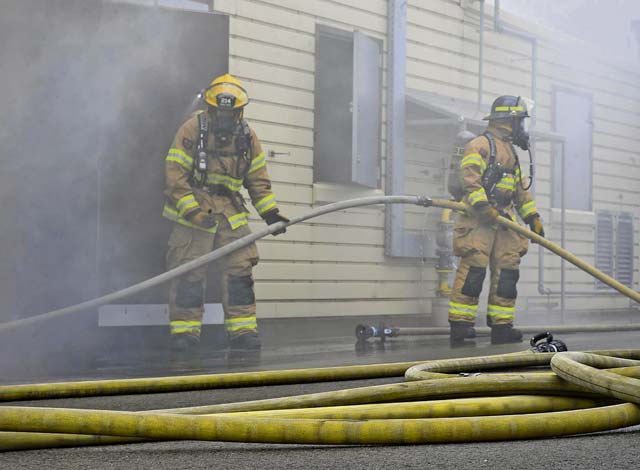
Lights flash as firetrucks pull up to a building. Smoke rolls from windows as firefighters quickly and strategically prepare fire hoses to enter. This training is crucial to ensure the KMC is taken care of in the event of a fire.
Firefighters from the 86th Civil Engineer Squadron participated in a biannual exercise June 2 to test their skills for real-world emergencies. Airmen train constantly to ensure their skills stay sharp.
“We trained for a typical response for our area of responsibility,” said Tech. Sgt. Daniel Linares, 86th CES district chief and incident commander. “We practice our skills to hone (them) at the basic level.
“During these trainings, we’re looking for competency,” Linares continued. “We’re looking to see if the Airmen are able to operate at the level they’re trained to. We also use this as an opportunity to see if maybe some of them can train even at the next level and step outside their comfort zone and expand their (knowledge).”
The 86th CES Airmen provide fire emergency services to Ramstein, Vogelweh, Rhine Ordinance Barracks and Landstuhl military sites.
Senior Airman Bradley Jenkins, 86th CES driver operator, said these kinds of training scenarios help the Airmen prepare for real fires, though the rush of excitement and some other elements could never be simulated.
“We’re doing the same steps as we would do in a real-world emergency, but nothing could replace a real fire,” Jenkins said. “The temperatures in these rooms aren’t the same as they would be in a real house fire. Overall, it absolutely helps us prepare for real situations, especially for the newer Airmen who have never fought fires. These trainings help them realize what we need to do if the situation arises.”
Linares said their work enables others to feel comfortable doing their job, knowing if there’s an emergency the 86th CES Airmen will be there to mitigate it.
“These trainings are extremely important because, for one, it gives us faith in each other to get the job done,” Linares said. “Having faith in each other extends to the public; then they’re able to have confidence in us.”
Being a firefighter gives me a feeling of almost invincibility, Jenkins said.
“I definitely get an adrenaline rush when we train,” Jenkins said. “There’s something about putting on all of the gear, having all the extra weight and carrying a heavy hose while fighting fire just gives me a sense of being able to do more than I normally would.”
Though the Airmen are required to conduct each type of training annually, they continuously work to maintain and expand their skill sets. Because of their hard work, dedication and timeliness, the KMC is in good hands.


